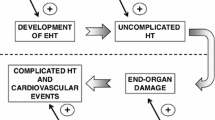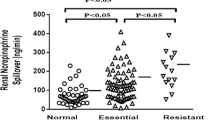Abstract
Hypertension is a common complication of chronic renal failure, accelerating the deterioration in renal function and constituting an important risk factor for the excessive cardiovascular morbidity and mortality. However, there are large gaps in our understanding of the pathogenesis and treatment of renal hypertension. Although this hypertension traditionally is thought to be largely volume dependent, an increasing body of literature suggests that there is an important sympathetic neural component. Microneurographic studies have demonstrated sympathetic overactivity without baroreflex impairment in both hypertensive chronic hemodialysis patients as well as in those with less advanced renal insufficiency. In a small group of patients with moderate chronic renal insufficiency and renin-dependent hypertension, sympathetic overactivity was normalized during antihypertensive monotherapy with the angiotensin converting enzyme inhibitor enalapril, but exacerbated by antihypertensive therapy with the dihydropyridine calcium channel blocker amlodipine. These results implicate a potentially important role for the sympathetic nervous system in explaining recent trial data suggesting an added renoprotective effect of antihypertensive agents that block the renin-angiotensin system. Future clinical trials are needed to determine whether normalization of sympathetic activity should constitute an important therapeutic goal to improve renal and cardiovascular outcomes in patients with chronic renal failure.
Similar content being viewed by others
References and Recommended Reading
United States Renal Data System: 1999 Annual Data Report. Bethesda: The National Institutes of Health, National Institute of Diabetes and Digestive and Kidney Diseases; 1999.
Levey AS: Controlling the epidemic of cardiovascular disease in chronic renal disease: where do we start? Am J Kidney Dis 1998, 32:S5-S13.
Cheigh JS, Milite C, Sullivan JF, et al.: Hypertension is not adequately controlled in hemodialysis patients. Am J Kidney Dis 1992, 19:453–459.
Salem MM: Hypertension in the hemodialysis population: a survey of 649 patients. Am J Kidney Dis 1995, 26:461–468.
Agodoa LY, Appel L, Bakris GL, et al.: Effect of ramipril vs amlodipine on renal outcomes in hypertensive nephrosclerosis: a randomized controlled trial. JAMA 2001, 285:2719–2728. The AASK study compared the effects of stringent blood pressure control with multidrug regimens that included either the ACE inhibitor ramipril or the dihydropyridine CCB amlodipine on the progression of hypertensive nephrosclerosis. In the patients with baseline proteinuria, the progression of renal failure was slower with the ramipril-based regimen. This is the first study to show an advantage of ACE inhibitors in hypertensive African-Americans, an ethnic group in which this class of antihypertensive agent has been thought to be relatively ineffective.
Lewis EJ, Hunsicker LG, Clarke WR, et al.: Renoprotective effect of the angiotensin-receptor antagonist irbesartan in patients with nephropathy due to type 2 diabetes. N Engl J Med 2001, 345:851–860. The Irbesartan in Type 2 Diabetics with Nephropathy Trial (IDNT) compared the effects of controlling blood pressure with older antihypertensive agents (diuretics, a-blockers, peripheral a-blockers, central sympatholytics) alone or in combination with either the ARB irbesartan or the dihydropyridine CCB amlodipine on the progression of moderately advanced diabetic nephropathy. Despite similar control of hypertension in all three study groups, the progression of renal failure was slower with irbesartan.
Brenner BM, Cooper ME, de Zeeuw D, et al.: Effects of losartan on renal and cardiovascular outcomes in patients with type 2 diabetes and nephropathy. N Engl J Med 2001, 345:861–869. The Reduction of Endpoints in Noninsulin Dependent Diabetes Mellitus with Angiotensin II Antagonist Losartan (RENAAL) trial compared the effects of multidrug regimens alone and in combination with the ARB losartan on renal and cardiovascular endpoints in patients with the early stages of type 2 diabetic nephropathy. In both study groups, the majority of patients were treated with dihydropyridine CCBs. The progression of renal failure was slower, and first hospitalizations for heart failure were reduced in the losartan group.
Lilley JJ, Golden J, Stone RA: Adrenergic regulation of blood pressure in chronic renal failure. J Clin Invest 1976, 57:1190–1200.
Nies AS, Robertson D, Stone WJ: Hemodialysis hypotension is not the result of uremic peripheral autonomic neuropathy. J Lab Clin Med 1979, 94:395–402.
Henrich WL, Katz FH, Molinoff PB, Schrier RW: Competitive effects of hypokalemia and volume depletion on plasma renin activity, aldosterone and catecholamine concentrations in hemodialysis patients. Kidney Int 1977, 12:279–284.
Baumgart P, Walger P, Gerke M, et al.: Nocturnal hypertension in renal failure, haemodialysis and after renal transplantation. J Hypertens Suppl 1989, 7:S70-S71.
Timio M, Lolli S, Verdura C, et al.: Circadian blood pressure changes in patients with chronic renal insufficiency: a prospective study. Ren Fail 1993, 15:231–237.
Timio M, Venanzi S, Lolli S, et al.: "Non-dipper" hypertensive patients and progressive renal insufficiency: a 3-year longitudinal study. Clin Nephrol 1995, 43:382–387.
Vallbo AB, Hagbarth KE, Torebjork HE, Wallin BG: Somatosensory, proprioceptive, and sympathetic activity in human peripheral nerves. Physiol Rev 1979, 59:919–957.
Converse RL Jr, Jacobsen TN, Toto RD, et al.: Sympathetic overactivity in patients with chronic renal failure. N Engl J Med 1992, 327:1912–1918.
Converse RL Jr, Jacobsen TN, Jost CM, et al.: Paradoxical withdrawal of reflex vasoconstriction as a cause of hemodialysisinduced hypotension. J Clin Invest 1992, 90:1657–1665.
DiBona GF, Kopp UC: Neural control of renal function. Physiol Rev 1997, 77:75–197.
Katholi RE, McCann WP, Woods WT: Intrarenal adenosine produces hypertension via renal nerves in the one-kidney, one clip rat. Hypertension 1985, 7:I88-I93.
Recordati G, Moss NG, Genovesi S, Rogenes P: Renal chemoreceptors. J Auton Nerv Syst 1981, 3:237–251.
Katholi RE, Winternitz SR, Oparil S: Decrease in peripheral sympathetic nervous system activity following renal denervation or unclipping in the one-kidney one-clip Goldblatt hypertensive rat. J Clin Invest 1982, 69:55–62.
Wyss JM, Aboukarsh N, Oparil S: Sensory denervation of the kidney attenuates renovascular hypertension in the rat. Am J Physiol 1986, 250:H82-H86.
Katholi RE: Renal nerves in the pathogenesis of hypertension in experimental animals and humans. Am J Physiol 1983, 245:F1-F14.
Zhang W, Li JL, Hosaka M, et al.: Cyclosporine A-induced hypertension involves synapsin in renal sensory nerve endings. Proc Natl Acad Sci U S A 2000, 97:9765–9770.
Johansson M, Elam M, Rundqvist B, et al.: Increased sympathetic nerve activity in renovascular hypertension. Circulation 1999, 99:2537–2542.
Kraus MA, Hamburger RJ: Sleep apnea in renal failure. Adv Perit Dial 1997, 13:88–92.
Hanly PJ, Pierratos A: Improvement of sleep apnea in patients with chronic renal failure who undergo nocturnal hemodialysis. N Engl J Med 2001, 344:102–107.
O’Sullivan DA, McCarthy JT, Kumar R, Williams AW: Improved biochemical variables, nutrient intake, and hormonal factors in slow nocturnal hemodialysis: a pilot study. Mayo Clin Proc 1998, 73:1035–1045.
Pierratos A: Nocturnal home haemodialysis: an update on a 5-year experience. Nephrol Dial Transplant 1999, 14:2835–2840.
Nordfors L, Lonnqvist F, Heimburger O, et al.: Low leptin gene expression and hyperleptinemia in chronic renal failure. Kidney Int 1998, 54:1267–1275.
Haynes WG, Morgan DA, Walsh SA, et al.: Receptor-mediated regional sympathetic nerve activation by leptin. J Clin Invest 1997, 100:270–278.
Hall JE, Hildebrandt DA, Kuo J: Obesity hypertension: role of leptin and sympathetic nervous system. Am J Hypertens 2001, 14:103S-115S.
Thomas GD, Zhang W, Victor RG: Nitric oxide deficiency as a cause of clinical hypertension: promising new drug targets for refractory hypertension. JAMA 2001, 285:2055–2057.
Vallance P, Leone A, Calver A, et al.: Accumulation of an endogenous inhibitor of nitric oxide synthesis in chronic renal failure. Lancet 1992, 339:572–575.
Campese VM, Kogosov E, Koss M: Renal afferent denervation prevents the progression of renal disease in the renal ablation model of chronic renal failure in the rat. Am J Kidney Dis 1995, 26:861–865.
Campese VM, Kogosov E: Renal afferent denervation prevents hypertension in rats with chronic renal failure. Hypertension 1995, 25:878–882.
Frohlich ED, Tarazi RC, Dustan HP: Re-examination of the hemodynamics of hypertension. Am J Med Sci 1969, 257:9–23.
Lazarus JM, Hampers C, Merrill JP: Hypertension in chronic renal failure. Treatment with hemodialysis and nephrectomy. Arch Intern Med 1974, 133:1059–1066.
Lazarus JM, Hampers CL, Bennett AH, et al.: Urgent bilateral nephrectomy for severe hypertension. Ann Intern Med 1972, 76:733–739.
DiBona GF: Central sympathoexcitatory actions of angiotensin II: role of type 1 angiotensin II receptors. J Am Soc Nephrol 1999, 10(Suppl 11):S90-S94.
Matsukawa S, Reid IA: Role of the area postrema in the modulation of the baroreflex control of heart rate by angiotensin II. Circ Res 1990, 67:1462–1473.
Ligtenberg G, Blankestijn PJ, Oey PL, et al.: Reduction of sympathetic hyperactivity by enalapril in patients with chronic renal failure. N Engl J Med 1999, 340:1321–1328. Sympathetic nerve activity was recorded with microelectrodes in a small cohort of predialysis patients with renin-dependent hypertension at baseline and after 4 to 6 weeks of monotherapy with either the ACE inhibitor enalapril or the dihydropyridine CCB amlodipine. Without antihypertensive treatment, sympathetic activity was higher in the patients with moderate renal insufficiency than in age-matched controls with normal renal function. After 4 to 6 weeks of antihypertensive therapy, sympathetic activity was normalized with enalapril but increased further with amlodipine.
Amann K, Rump LC, Simonaviciene A, et al.: Effects of low dose sympathetic inhibition on glomerulosclerosis and albuminuria in subtotally nephrectomized rats. J Am Soc Nephrol 2000, 11:1469–1478.
UK Prospective Diabetes Study Group: Efficacy of atenolol and captopril in reducing risk of macrovascular and microvascular complications in type 2 diabetes: UKPDS 39. BMJ 1998, 317:713–720.
Author information
Authors and Affiliations
Rights and permissions
About this article
Cite this article
Tuncel, M., Augustyniak, R., Zhang, W. et al. Sympathetic nervous system function in renal hypertension. Current Science Inc 4, 229–236 (2002). https://doi.org/10.1007/s11906-002-0012-7
Issue Date:
DOI: https://doi.org/10.1007/s11906-002-0012-7




